Iron Age Ireland 200BC – AD 500
The Iron Age is defined in Ireland by the introduction of the La Téne design of metalwork, a style that is closely associated with the Celts. The finds from this period such as ornaments, horse tack and weaponry are associated with aristocratic members of society. There is little evidence of Iron Age settlement in Ireland apart from at the ‘royal’ sites of Tara, Co. Meath, Dún Ailinne on the hill of Knockaulin, Co. Kildare and Navan Fort. Again there is little burial evidence from this period, suggesting cremation was the most common method and the few grave goods found consisted of personal possessions such as pottery or weapons.
Navan Fort in the Iron Age 200 BC
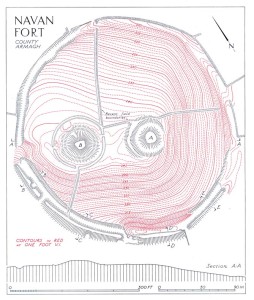
Plan of Navan Fort showing Site A and Site B
Around Navan Fort, there was a resurgence of woodland c. 200 BC suggesting the collapse of agriculture, abandonment or population decline. The forest regeneration coincides with a rise in lake levels suggesting an increase in rainfall. These climatic changes coincide with an upsurge in ceremonial activity including the building of the mound at site B on Navan Fort and the deposition of the trumpets in Loughnashade. By the first or second centuries AD this decline was reversed and arable agriculture was again on the rise.
Navan Fort Site A & Site C in the Iron Age
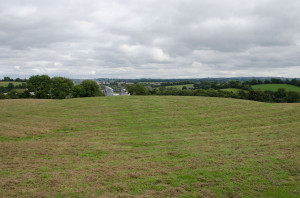
Navan Fort site A Ring Barrow
The centre of the ring work lies 30m South-East of the centre of the enclosure. A wide hollow ring marks the line of a filled in ditch 30m in diameter and 2m deep, with traces of an external bank to the North and West. When complete the whole monument would have been 50m in diameter. The small internal area and lack of entrance and external bank suggest it was used as a ceremonial monument. A number of finds were discovered in the filled-in ditch including an Early Christian bronze brooch but radiocarbon dating of animal bones found at a lower level point to a much earlier date of occupation. Underneath the existing ring barrow, archaeologists discovered a series of three concentric circular trenches. These trenches were flat-bottomed and steep-sided with the largest measuring 20m in diameter and 0.75m deep. Excavations showed that the trenches were dug in sequence; the middle first then the outer then the inner. The inner wall trench represented the position of a timbered wall with vertical posts spaced a metre apart.
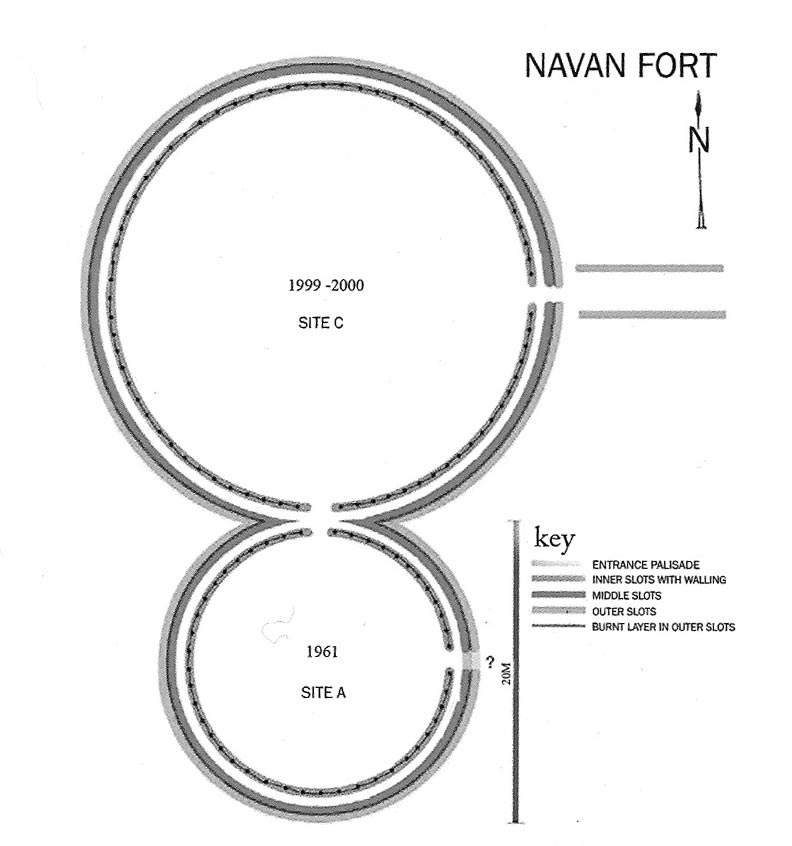
Navan Fort in the Iron Age – Site A & C Figure of Eight structure
Bronze Age pottery was found in this occupation layer suggesting the existence of a large wooden building probably of the Late Bronze Age. However, in 1993, geophysical surveys found an additional circular feature, 30m in diameter, North-West of site A. The survey of site C revealed two concentric circles, placed 2m apart. Site C was excavated between 1999-2002. The strong outline identified in the survey had been created by burnt material in the upper fill of two concentric trenches. An inner, third slot was also revealed, forming three concentric slots like those found under site A. The inner ring had contained spaced vertical posts and plank walling which seemed to have been burnt in situ. The inner and outer slots contained a high volume of burnt bone. Some 2000 small pieces were discovered suggesting a ritual practice involving animal cremation. The three concentric circles at site C were found to join on to the slots under site A. Together these circular slots would have created a large figure of eight structure, 50m long. With no evidence of internal supports it is unlikely that this large structure had a roof. Originally thought to be of Late Bronze Age, it is now assumed to be an Iron Age extension of the site B figure of eight structures and contemporary with the construction of the mound at site B. This large building is considered to have had a ceremonial purpose.
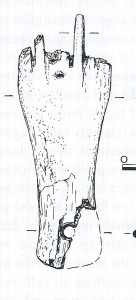
Navan Fort in the Iron Age – Site A – a weaving comb made of Antler
The most unusual find at site A was a piece of antler carved with teeth to form a ‘weaving comb’ – an item characteristic of the Early Iron Age and only the second to be found in Ireland.
Navan Fort Site B figure of Eight wooden structures – Late Bronze Age/ Early Iron Age
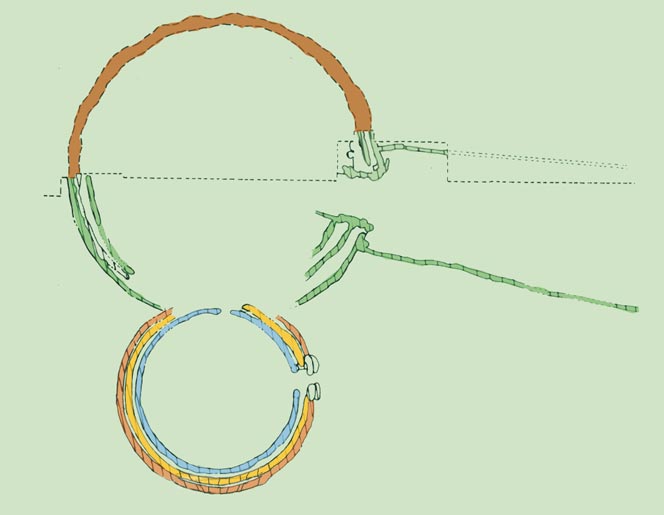
Navan Fort in the Iron Age – Site B Figure of Eight Structure [copyright NIEA]
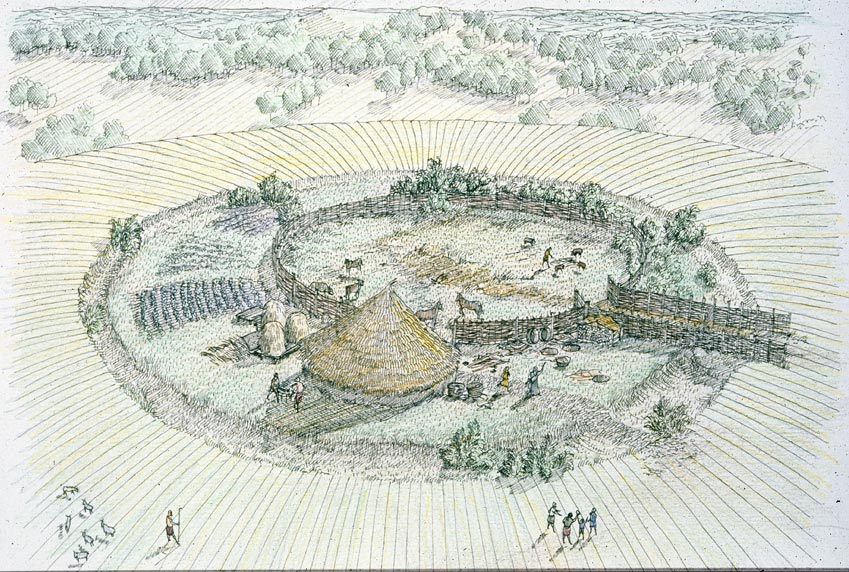
Navan Fort in the Iron Age – Reconstruction of the Figure of Eight Structure [copyright NIEA]
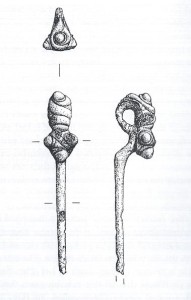
Navan Fort in the Iron Age – Site B – Iron Age Pin
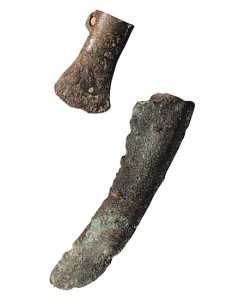
Navan Fort in the Iron Age – Site B – Late Bronze Age socketed axehead and sickle blade
Underneath the mound, a number of finds associated with the Late Bronze Age were discovered; these included ‘flat-rimmed ware’ and four bronze objects: a socketed axehead, a tiny spearhead, a sickle blade and a mount from a scabbard. An Iron Age bronze pin was also discovered suggesting that occupation of this layer continued from the Late Bronze Age through to the Early Iron Age. The Iron Age pin has a ring head decorated with raised spiralling bosses in the La Téne style and is only one of six found in Ireland. Among the animal bones, archaeologists were surprised to find a Barbary Ape skull. The animal would have come from North Africa or Spain, and its presence suggest that those who occupied the site were of high status.
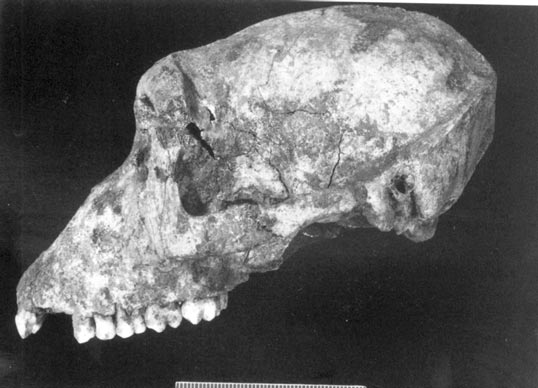
Navan Fort in the Iron Age – Site B Barbary Ape Skull
Navan Fort Site B – Iron Age Ceremonial Mound
The mound at Site B was 6m high and 50m in diameter and constructed in the Iron Age for some unknown ceremonial practice. In the 1960s, the entire structure was excavated except for a small segment saved for future excavations. The mound was found to consist of the burnt remains of a large wooden building packed with limestone boulders and covered with layers of soil and turves.
-
Navan Fort Site B Mound
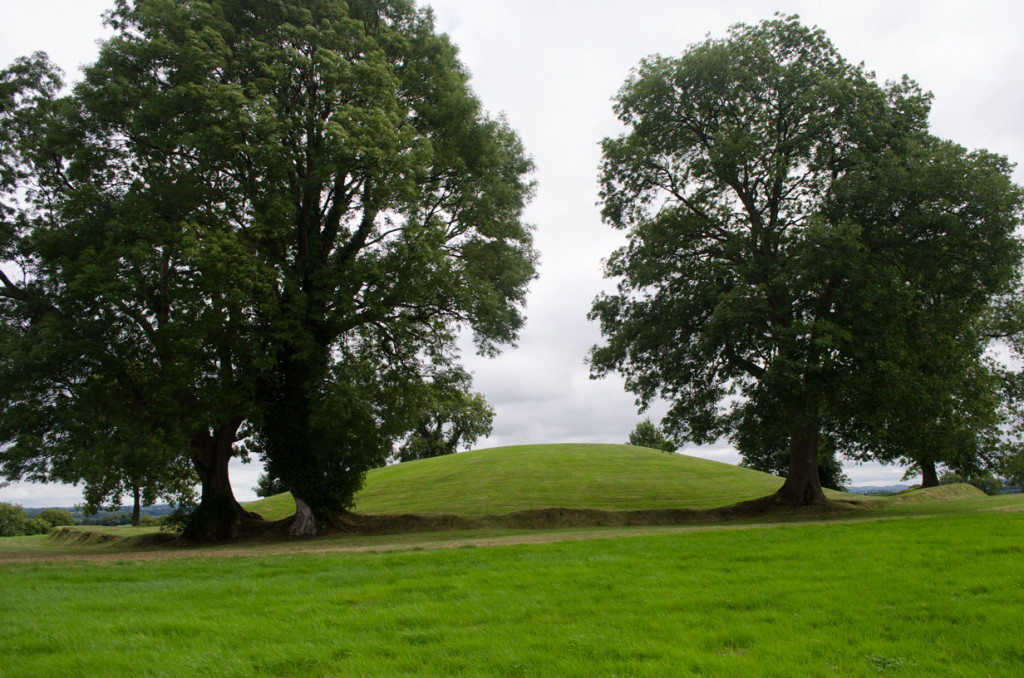
Navan Fort in the Iron Age – site B – ceremonial mound
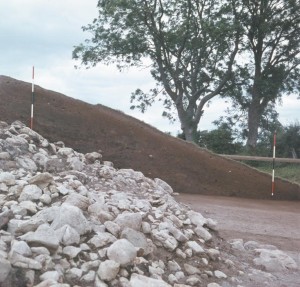
Navan Fort in the Iron Age – Site B cross-section of mound
During excavations, the mound was found to consist of deliberately assembled horizontal layers of soil and turves. From the number and composition of these layers, it was clear that not all the turves and soil were from the locale. The layer of top soil and turves was 2.5m deep and rested on a layer of boulders.
-
Navan Fort Site B Stone Cairn
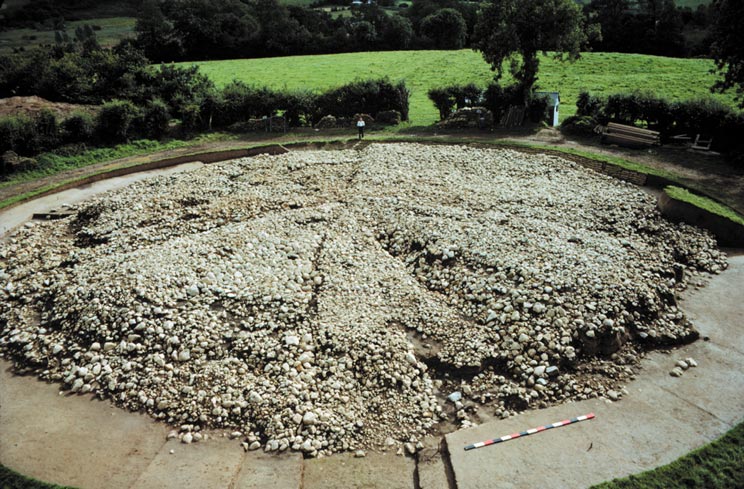
Navan Fort in the Iron Age – Site B Stone Cairn
The uncovered stone cairn was flat at the top and divided into wedges radiating from the centre. Different sized boulders distinguished each segment with larger boulders forming the curved outer edge. There were also slight differences in height between adjacent wedges; and sometimes radial hollows between them. The width and distribution of wedges were not uniform. This was considered to be deliberate surface treatment, resulting perhaps from different groups of workers bringing stones from various locations. The stones were of a variety of sizes from cobble up to football and were somewhat rounded, suggesting they were not freshly quarried. Most boulders were of fossiliferous limestone from the immediate vicinity, but again there were some stones sourced from other locations.
-
Navan Fort Site B Wooden Building
During the removal of the cairn, a large void, was discovered. As the stones were removed, further pits revealed the presence of large, 30cm diameter, vertical timbers in four concentric circles. More than 200 post-holes, 3m apart, were discovered. These large posts had rotted away to leave holes full of dark soil. The post butts which survived deeper underground had been cut with a metal-bladed axe indicating that the construction was post-Neolithic. The stone cairn was surrounded by a trench and post-pits suggesting the presence of a wall made of oak planks supported by spaced posts. The main wall was held up by 34 pairs of posts set in large pits 3.5 m apart. This wall was surrounded by a narrow trench or slot 1m further out that may have held a perimeter fence which defined the site during building but was not used in the final completed structure. These timber remains indicated that the cairn was placed inside a large wooden building. The wooden building would have been 40 m in diameter; the largest single integrated wooden structure known in prehistoric Ireland. The remains of the wall showed evidence of burning. Evidence of kindling, burnt soil and charcoal showed that burning was consistent and a fire had been purposely set. The large wooden building had burned down after the stones were placed inside but before the earth mound was created.
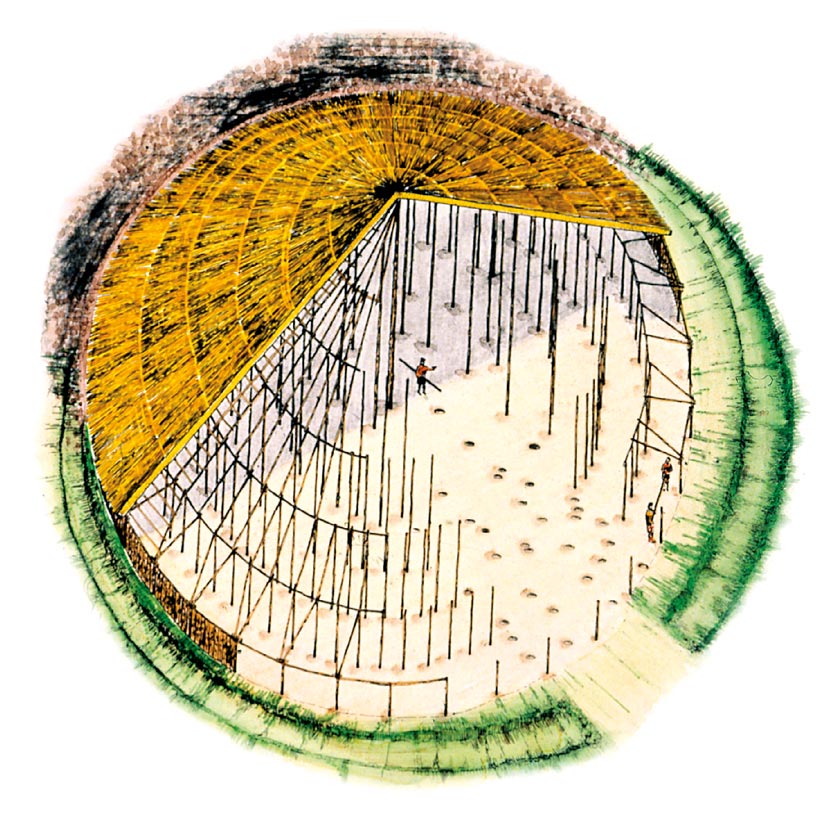
Navan Fort in the Iron Age – Site B Large Wooden Building
Once the the stone cairn was removed, archaeologists were able to examine the clay floor of the wooden building, however no artefacts were found, providing no evidence of any activity. On the western side of the building the concentric circles gave way to four parallel rows running from the outer wall to the centre of the building, creating a covered walkway. This feature is seen in the East end of some medieval churches and is normally used for processions. This walkway consisted of three parallel aisles which focussed on a huge isolated post at the centre of the building. The centre post was approximately 50cm in diameter, the size of the trunk of an oak tree. This post was evidently so long and heavy that builders had to make a ramp 6m long sloping into the bottom of the pit from the west in order to raise it. The erected post would have stood 10 m high but it did not serve a structural purpose. There was no evidence of burnt roofing material found on top of the cairn, however the posts around the outer sections of the building had been pushed down into the subsoil by 10 – 15 cm from the original excavated post-hole. This suggests they carried more than their own weight. The original outer posts had an additional secondary support post to counteract the downward pressure. The ritual destruction of the building suggest the structure was sacrificed to the otherworld in accordance with continental Celts and early Irish belief.
Navan Fort in the Iron Age – Loughnashade
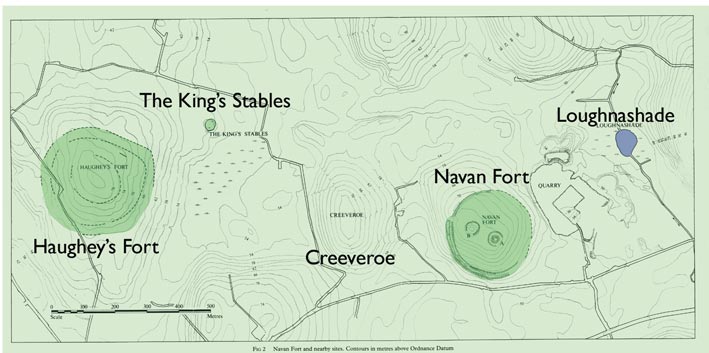
Plan of the Navan Fort Complex
Loughnashade (‘the lake of treasures’) lies 550m to the North-East of Navan Fort. This small natural lake has ben reduced in size by the effects of quarrying and originally covered 8ha. The discovery of four trumpets on its margins in 1798, as well as human skulls and other bones indicate that the lake was uses as a votive (offering) pool. The surviving Loughnashade trumpet is skilfully crafted out of sheet bronze and topped with a bronze disc decorated in the La Téne style. These trumpets would have been used for special occasions or ceremonies; perhaps for processions or military confrontations. The trumpets were deposited in the lake as a water offering, this is consistent with the European-wide trend for using water sources as a focus for ritual. The La Téne decoration of the trumpet dates the use of Loughnashade as a votive pool to the Iron Age making it contemporary with Navan Fort and perhaps part of Navan Fort’s ceremonial practices.
![Loughnashade Trumpet [A History of Ireland in 100 objects]](http://www.100objects.ie/wp-content/uploads/2012/10/Trumpet-Detail.jpg)
Loughnashade Trumpet [A History of Ireland in 100 objects]
The Dorsey Early Iron Age
Around Ulster there is a series of linear earthworks; a combination of ditches, earthen banks and timber palisades which stretch over the countryside. These earthworks occupy strategic places such as passes or overlooking fords and may have served as boundaries in prehistoric times. In Armagh, straddling the main pass to the south is the linear earthwork known as the Dorsey. The main earthwork consists of a large bank with a deep ditch on either side. It is 700m long and crosses two parallel ridges at a point where they are transversed by an ancient routeway. The monument has often been linked to Navan Fort. The Annals of Clonmacnoise referred to the Dorsey in 1224 as ‘doirsiu Emna’ – the doors/gates of Emain. It is thought that like ‘Black Pig’s Dyke’, the Dorsey was designed not to block the route but to channel access through defined gaps. Perhaps used by the Ulaidh as a ‘temporary Kraal’ into which herds of cattle could be driven and defended. In 1977 a layer of charcoal from the earthwork was carbon-dated and timbers were found to have been felled between 400BC – 1BC, contemporary with the Late Bronze Age/ Early Iron Age activity at Navan Fort. If as assumed Navan Fort was used as a sanctuary or for ceremonial activity in the Iron Age perhaps the Dorsey had a religious function defining the limit of sacred territory rather than acting as a defensive boundary.
